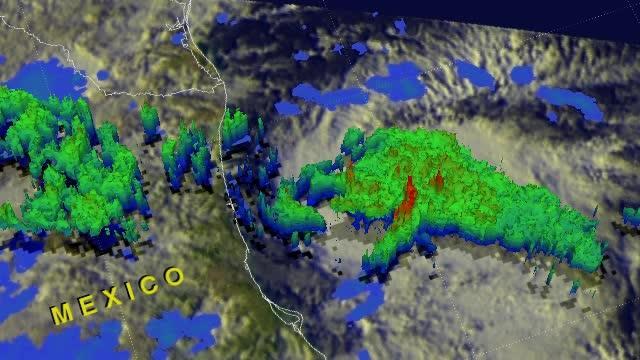What was a tropical storm rapidly intensified into Typhoon Usagi within 24 hours as it moves through the Northwestern Pacific Ocean. NASA satellite data revealed a 20-mile-wide eye and bands of thunderstorms spiraling into the center of the monster storm.
Heavens
Habitable conditions on Earth will be possible for at least another 1.75 billion years – according to astrobiologists at the University of East Anglia.
Findings published today in the journal Astrobiology reveal the habitable lifetime of planet Earth – based on our distance from the sun and temperatures at which it is possible for the planet to have liquid water.
The research team looked to the stars for inspiration. Using recently discovered planets outside our solar system (exoplanets) as examples, they investigated the potential for these planets to host life.
Microscopic, bottle-like structures with corks that melt at precisely-controlled temperatures could potentially release drugs inside the body or fragrances onto the skin, according to a recently published study.
By analyzing the distinctive cracks lining the icy face of Europa, NASA scientists found evidence that this moon of Jupiter likely spun around a tilted axis at some point.
This tilt could influence calculations of how much of Europa's history is recorded in its frozen shell, how much heat is generated by tides in its ocean, and even how long the ocean has been liquid.
A team of researchers led by King's College London has for the first time identified a new gene which may have the ability to prevent HIV, the virus that causes AIDS, from spreading after it enters the body.
Published in Nature today, the study is the first to identify a role for the human MX2 gene in inhibiting HIV. Researchers say this gene could be a new target for effective, less toxic treatments where the body's own natural defence system is mobilised against the virus.
Powerful thunderstorms wrapped around Tropical Storm Usagi's center and its southern quadrant in visible data from NASA's Aqua satellite on Sept. 18.
When NASA's Terra satellite passed over Tropical Storm Humberto on Sept. 17, the MODIS instrument aboard took a picture of the storm and it resembled the letter "A" as it moves through the northeastern Atlantic Ocean.
NASA's Aqua satellite caught the birth of the eighteenth tropical depression of the northwestern Pacific Ocean tropical cyclone season. Tropical Depression 18W was born in the South China Sea and is expected to be short-lived after a quick landfall in central Vietnam.
Infrared data provides a look at cloud top temperatures in tropical cyclones and there were very cold cloud tops in the thunderstorms banding around the south of newborn Tropical Storm Usagi's Center.
On Sept. 16, low pressure System 99W strengthened into Tropical Depression 17W. The depression became Tropical Storm Usagi very late in the day.
Located around 6000 light-years from Earth in the constellation of Scorpius (The Scorpion), the nebula formally known as IC 4628 is a huge region filled with gas and clumps of dark dust. These gas clouds are star-forming regions, producing brilliant hot young stars. In visible light, these stars appear as a blue-white colour, but they also emit intense radiation in other parts of the spectrum — most notably in the ultraviolet [1].
NASA's TRMM satellite watched Tropical Storm Humberto's rainfall pick up over two days as it re-formed, and as part of NASA's HS3 mission, two of NASA's Global Hawk unmanned aircraft have been investigating the zombie storm. The two Global Hawks also celebrated a combined 100 flights.
TRMM satellite data from Sept. 16 at 0227 UTC (Sept. 15 at 10:27 p.m. EDT) were used to create a 3-D image of Ingrid's rainfall. That 3-D image of Tropical Storm Ingrid's rainfall showed heaviest rainfall appeared over the Gulf of Mexico, where rain was falling at a rate of 2 inches/50 mm per hour. Moderate rainfall stretched from the Gulf northwest and inland over eastern Mexico.

Tropical Storm Manuel dropped very heavy rains that caused floods and mudslides and took lives on Mexico's Pacific coast. Manuel's rainfall was captured and tallied from NASA's Tropical Rainfall Measuring Mission satellite known as TRMM.
Humberto is the second "zombie" tropical storm of the Atlantic Ocean season. That is, it's the second tropical storm that degenerated into a remnant low pressure area only to make a comeback as a tropical storm. NASA's HS3 hurricane mission sent an unmanned Global Hawk Aircraft out to the eastern Atlantic to investigate Humberto on Sept. 16.
Tropical Storm Manuel was soaking southwestern Mexico while Tropical Storm Ingrid was soaking eastern Mexico on Sept. 16. NASA's Aqua satellite passed over Manuel and the AIRS instrument captured infrared data that showed powerful thunderstorms were dropping heavy rainfall. However, Manuel's interaction with land caused the storm to dissipate on Sept. 16.